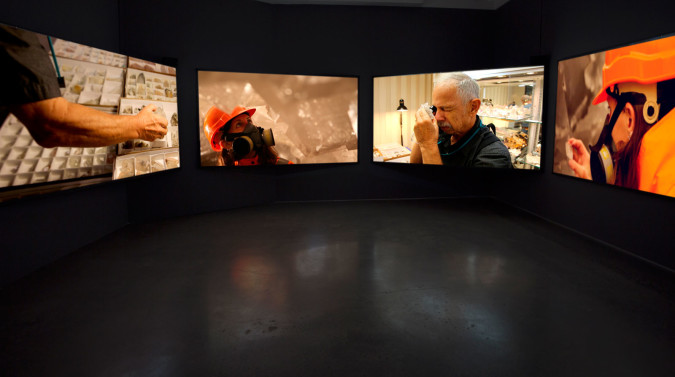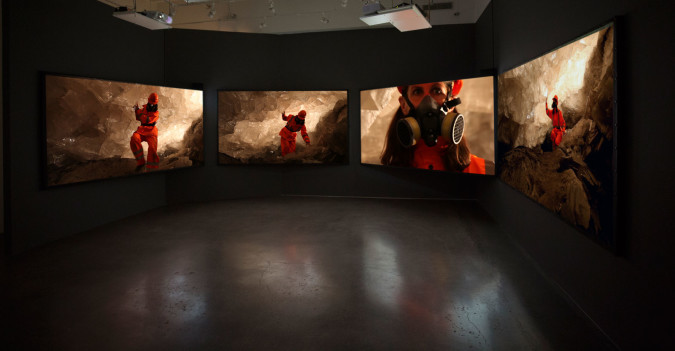Janet Biggs
Janet Biggs is an American artist, known primarily for her work in video, photography and performance. She lives and works in Brooklyn, New York. Biggs’ work often includes images of individuals in extreme landscapes or situations. She has captured such events as speeding motorcycles on the Bonneville Salt Flats, Olympic synchronized swimmers in their attempts to defy gravity, kayaks performing a synchronized ballet in Arctic waters, sulfur miners inside an active volcano, and a camel caravan crossing the Taklamakan desert of Western China. Her earlier work dealt with issues of psychosis and psychotropic drugs. Her latest project explores the creation and loss of memory from personal, physical, and scientific perspectives. In addition to videos, her recent work includes multi-discipline performances, often including multiple large-scale videos, live musicians, and athletes.
She has had solo exhibitions and film screenings at the Blaffer Art Museum, Houston, Texas; Musee d’art contemporain de Montréal; Hirshhorn Museum and Sculpture Garden; the Armory Art Fair; Skulpturenmuseum Glaskasten Marl; Herbert F. Johnson Museum of Art; Mint Museum of Art; Everson Museum of Art; Gibbes Museum of Art; Rhode Island School of Design Museum; and the Perth Institute of Contemporary Arts, Australia; among others. In 2011, the Tampa Museum of Art presented a survey exhibition of Biggs’ work. Her work has been featured in the first International Biennial of Contemporary Art of Cartagena, Colombia; the Musée d’art contemporain de Lyon, France; Vantaa Art Museum, Finland; Linkopings Konsthall, Passagen, Sweden; the Oberosterreichisches Landesmuseum, Austria; Kunstmuseum Bonn, Germany; Museo d’arte contemporanea Roma, Italy; and the National Taiwan Museum of Fine Arts, Taiwan. Reviews and features of her work have appeared in the New York Times, the New Yorker, ArtForum, ARTNews, Art in America, Flash Art, Artnet.com, and many others.
Janet Biggs works with Cristin Tierney Gallery, New York, NY, CONNERSMITH, Washington, DC, and Analix Forever, Geneva, Switzerland.
Question:
Your videos often document a struggle for survival against extreme circumstances, from living in the uninhabited deserts of China, to working in a dangerous Arctic coal mine miles beneath the earth’s surface. In Can’t Find My Way Home, the struggle you explore is not environmental, but internal: the work is a larger metaphor for your grandfather’s struggle with Alzheimer’s. While unable to recall the names of his family and friends, he could always remember the names of each obscure gem in his collection, and so for the video, you put yourself into crystalized underground caves that resemble a human hippocampus. Can you talk about your experience of climbing through the caves on your own? Do you remember what you were thinking about, and were any of those thoughts reflected in the composition of the final piece?
Answer:
I filmed Can’t Find My Way Home in both a bio-chemical research laboratory and in a cavern some 800 meters down and 26 kilometers into the earth.
I researched a number of caverns with extraordinary crystal formations, looking for something that would allow me to feel as if I had stepped inside a geode. I set off on an expedition with the intent of both metaphorically and physically tracing memories of my grandfather’s moments of presence within the vast sea of loss that is Alzheimer’s disease.

Janet Biggs, Can’t Find My Way Home, 2015 (installation view at Cristin Tierney Gallery, New York, NY). Four channel, HD video installation with sound. Running time: 08:19. Courtesy of the artist, Cristin Tierney Gallery, NYC, CONNERSMITH, Washington DC, and Analix Forever, Geneva, Switzerland.
I decided on the Merkers crystal cavern in Germany for a number of reasons. It was definitely immersive, absolutely gorgeous and otherworldly, but there were some specific details that made me sure it was the right location. The shape of the cavern is a negative of the shape of the hippocampus, the location of memory within a brain. Also, the crystal formations had an uncanny similarity to the shape of amyloid proteins and tau tangles in the brain of someone with Alzheimer’s disease … not so astonishing as nature tends to repeat forms, but a pretty profound discovery for me.
I also thought that the conditions in the cavern, the extreme heat and the need to filter particles in the air with a respirator, might challenge me physically and cause disorientation … perhaps echoing some of the same sensations that my grandfather experienced as the disease progressed. It did that and then some. I was extremely disorientated and confused by the end of a day of filming, so much so that I had trouble finding my way out of the cavern.

Janet Biggs, Can’t Find My Way Home, 2015 (installation view at Cristin Tierney Gallery, New York, NY). Four channel, HD video installation with sound. Running time: 08:19. Courtesy of the artist, Cristin Tierney Gallery, NYC, CONNERSMITH, Washington DC, and Analix Forever, Geneva, Switzerland.
So, on one hand, I have this intense physical experience inside the cavern that alters my perceptions of things around me, which I juxtapose with the sterile, quantifiable, scientific methodology of a bio/chem-lab. This allowed me to trace both the emotional and physical, as well as the biological sides of my memory.
I had been researching the work of Dr. Jokubas Ziburkus, a professor at University of Houston. He has been able to record the sounds of individual cells talking to each other in a hyperactive brain. Things like seizures, brain trauma, and Alzheimer’s disease all cause a hyperactive state in the brain. I filmed professor Ziburkus’ Ph.d candidate Mahshid Sadat Hosseini-Zare as she takes a disembodied brain from a rat that was bred for predisposition to seizures and places it under a high powered microscope that can identify individual cells in the brain. They are able to keep the brains viable for days after surgically removing them from the rat’s body. She uses audio sensors and permeates the exterior membrane of two individual cells to record the sound of “normal” brain cells talking to each other. She then increases the heat and decreases magnesium to create a seizure and records the sound of cells communicating in a hyperactive brain. I used both the visual footage of this process in my video and the recorded sound as part of the soundtrack for my piece.

Janet Biggs, Can’t Find My Way Home, 2015 (detail). Four channel, HD video installation with sound. Running time: 08:19. Courtesy of the artist, Cristin Tierney Gallery, NYC, CONNERSMITH, Washington DC, and Analix Forever, Geneva, Switzerland.
While exploring the cavern, I would have moments where a minute detail, a small gesture would be as powerful as being surrounded by twenty tons of gigantic crystals. It became essential for seemingly opposite elements and actions to coexist in my work. Hard and soft, organic and inorganic, stay or go. All these elements or actions have the potential to cancel each other out, or the potential to create a new state or possibility.





